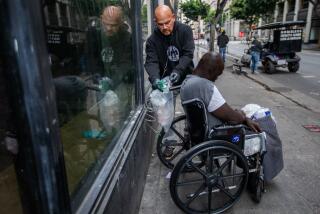Breathing Room for Respiratory Patients? : Medicine: Tests will begin on a sort of artificial lung that could help thousands of patients a year.
- Share via
SALT LAKE CITY — Human tests will begin soon on a device that supplies oxygen to the bloodstream while removing carbon dioxide, a sort of artificial lung that developers say could help tens of thousands of people each year.
The IntraVascular Oxygenator can be used up to seven days, satisfying as much as half the body’s needs, developers say. It isn’t a lung replacement but a lifesaving boost to see a patient through a crisis.
“This device does not heal the lung,” said Dr. Terry Clemmer, chief of critical-care medicine at LDS Hospital in Salt Lake City. “This device buys us some time . . . to create an environment more conducive to healing the lung.”
The IVOX, developed by Dr. J. D. Mortensen, is inserted into the inferior vena cava, the large vein carrying blood to the heart, through an incision in the neck or groin. A bundle of tubes in it carries oxygen to the blood; carbon dioxide passes through fiber walls into the tubes and out of the body. It uses new membrane technology to provide as much oxygen as larger, external devices.
The surface area of the human lung is roughly that of a tennis court, said Dr. John Watson, chief of cardiovascular devices at the National Heart, Lung and Blood Institute in Bethesda, Md. The IVOX is “nowhere near the size of a tennis court, but he’s certainly been able to squeeze a large surface area into a relatively small device. And that’s by using these hollow fibers.”
The clinical evaluations are expected to show that a patient suffering acute respiratory failure can be supported more safely and at lower cost with IVOX than with current methods, Mortensen said. In animal tests lasting up to 19 days, it didn’t damage the blood or organs in 150 sheep and dogs.
The first phase of human tests will involve 10 patients and will begin once they’re chosen. It is intended to confirm the animal results and IVOX’s safety; a second, broader, study of its effectiveness could begin this summer.
In addition to LDS, medical centers in the first phase are Los Angeles County-USC Medical Center, Penn State’s Hershey Medical Center and the University of Michigan Medical Center in Ann Arbor. The Hershey and LDS teams received the first devices in March.
IVOX was developed and manufactured at CardioPulmonics, a Salt Lake City-based firm specializing in the development of gas-permeable membranes and specialized critical-care devices. Mortensen, CardioPulmonics chairman, had produced an earlier version that didn’t exchange enough gases.
In September, the Food and Drug Administration approved an investigational device exemption that cleared the way for limited human testing; after both phases are complete, the data will be reviewed by the FDA.
IVOX could be used in situations where a patient is breathing oxygen through a nasal mask or an endotracheal tube and ventilator that aren’t working well, Mortensen said. It also could help patients recover from acute episodes of respiratory failure resulting from inhalation of smoke or noxious agents, drugs, severe pneumonia and scores of other ailments. He said it could help tens of thousands of people each year.
“As far as its clinical benefit, that’s still to be determined,” Watson said. “Basically, this type of step forward sort of opens the door.”
Patients who would qualify during Phase 1 must be extremely sick, near death and require pure oxygen, Mortensen said. Most will see benefit in two to five days, when they can change to a regular ventilator.
Those who don’t improve would present an ethical dilemma, though Mortensen and Clemmer say such cases would be unusual.
“If they become dependent on the device to avoid death, that is one of my greatest fears because it’s only approved for seven days,” Clemmer said. In a case like that, he said, hospital officials and the patient’s family would have to decide whether to leave the patient on the device past the test period.
Before IVOX, the only support for patients with respiratory failure has been mechanical ventilation, in which oxygen at varying concentrations is blown into the lung under pressure. However, the pressure and high concentrations can damage already weakened lungs. By reducing the time a patient is attached to a respirator, developers say, costs and mortality can be reduced.






